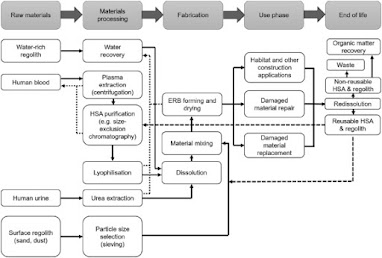Colonization on Mars has always been a lofty, elusive, and faraway goal. The fantasies of living on the distant red planets has been the stuff of science fiction media and space fanatics. As time has gone on, humanity has learned more and more about Mars, and perhaps one obstacle to our dreams of colonization has been solved.
In his Newsweek article "Astronaut Blood, Sweat, Tears, Urine and Space Dust Could Be Used To Build Homes on Mars", Robert Lea summarizes findings by the University of Manchester in the possible future of Martian infrastructure. An entirely new substance created solely from human bodily fluids and Martian soil has been discovered and tested as an alternative to earthly building materials such as wood and concrete; this mixture is known as AstroCrete.
While there are a number of issues preventing Martian colonization, one such pressing issue was the thought of building shelter and infrastructure for future humanity. Shipping materials from Earth is an option, but one that is impractical. The cost to ship a singular brick from Earth to Mars is estimated to be around 2 million dollars. AstroCrete can be created on Mars using the very land and the human body itself. AstroCrete is a mixture of Martian dust and human serum albumin (HSA). This mixture has the potential to be strengthened further with the addition of urea, found in human tears, sweat, and urine. The article states, "Researchers calculated that six astronauts on a two-year mission could create around 1,200 pounds of high-strength AstroCrete" (Lea, 2021).



Good headline and lede which leaves us wondering about what problem has been solved encouraging us to read on. Your basic explanation is good. I found myself wondering about HSA extraction. Studying the flow chart suggests that it is extracted from the blood by centrifugation and purified by chromatography. I wonder if the blood cells separated by centrifugation would be returned to the body preventing anemia and allowing more blood to be processed. Perhaps just a bit more explanation of that process would be helpful to the general reader. The graphics are effective. The flow chart is effective if a little hard to read. Overall an effective post.
ReplyDelete